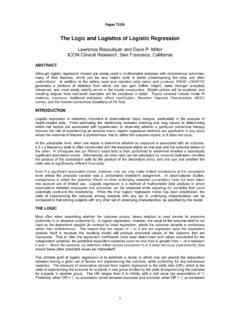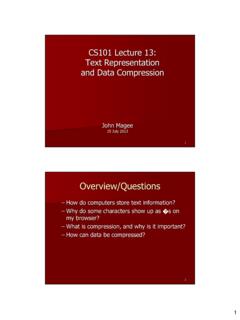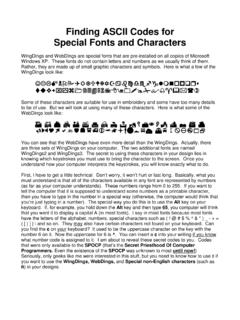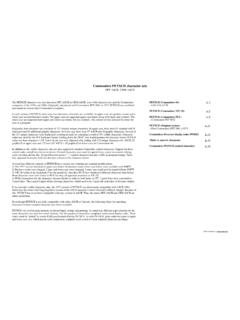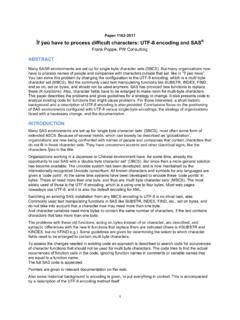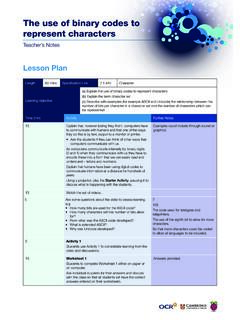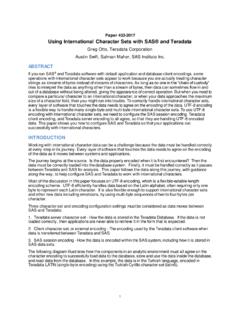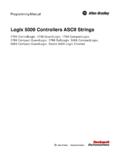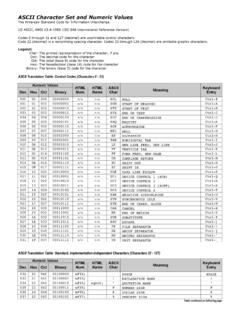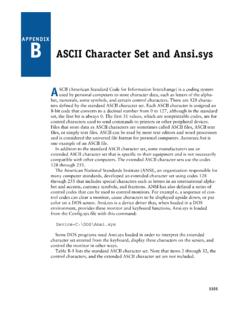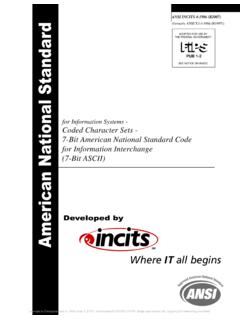Transcription of Non Printable & Special Characters: Problems and …
1 Non Printable & Special Characters: Problems and how to overcome them Sridhar R Dodlapati, i3 Statprobe, Basking Ridge, NJ Praveen Lakkaraju, Naresh Tulluru and Zemin Zeng Forest Laboratories Inc. Jersey City, NJ ABSTRACT Non Printable & Special characters in clinical trial data create potential Problems in producing quality deliverables. There could be major issues such as incorrect statistics / counts in the deliverables, or minor ones such as incorrect line breaks, page breaks or appearance of strange symbols in the reports. Identifying and deleting these issues could pose challenges. When faced with this issue in the Pharmaceutical & Biotech industries, it is imperative to clean them up. We need to understand the underlying cause and use various techniques to identify and handle them.
2 KEY WORDS Non Printable , Invisible, Special , ascii table, TRANTAB, Compress, K & W modifiers, Indexc, Byte and Rank. INTRODUCTION When SAS programmers encounter any non Printable & Special character related issues in clinical trial data for the first time, it might be time consuming to figure out the reason that is causing the problem . In this paper we are trying to provide an awareness of non Printable & Special characters, discuss issues that might be caused by them and provide corresponding solutions. In this paper we have used "NPSC" as a short form for non Printable & Special characters for convenience. The macros and the examples used in this paper are implemented on UNIX operating system with SAS version BACKGROUND INFORMATION Some of the most common non Printable characters are carriage return, form feed, line feed, backspace, escape, horizontal tab and vertical tab.
3 These might not have a visible shape but will have effects on the output. To further understand them, we have to look into ascii table. ascii TABLE ascii stands for American Standard Code for Information Interchange. ascii was originally designed for use with teletypes. Computers can only understand numbers; hence an ascii code is the numerical representation of a character such as 'a' or 'A' or an action such as 'ESC' or 'DEL'. There are total of 256 ascii characters (including extended ascii characters) (decimal values range from 0 to 255). Tables 1, 2 & 3 in Appendix show details of the ascii characters. For the purpose of our topic, we can broadly classify the characters into 3 groups: 1. 33 non Printable Special characters. The first 32 characters (decimal value from 0 to 31) and the DEL char (decimal value 127).
4 2. 94 standard Printable characters (decimal value range from 33 to 126) which represent letters, digits, punctuation marks, and a few miscellaneous symbols. 3. 128 Special characters (Extended ascii or ISO-8859-1. Decimal values range from 128 to 255). Decimal values from 128 to 159 in the Extended ascii set are non printing control characters. The "Space" character (decimal value 32) denotes the space between words, as produced by the space bar of a keyboard and it is considered as an invisible graphic rather than a control character . All the characters that correspond to decimal values between 0 and 127 represent the standard ascii character set (Standard across the operating environments operating system / application / font). Other ascii characters that correspond to decimal values between 128 and 255 are available on certain ascii operating environments, but the information those characters represent varies with the operating environment.
5 As the need for understanding 1 Foundations and FundamentalsNESUG 2010additional characters and non printing characters by computers has risen, the standard character set of ascii became restrictive and a few varying 'extended' sets have been put in place. Problems CAUSED BY NON Printable & Special CHARACTERS In Clinical trials data, we do not expect to have any characters outside the decimal values range from 32 to 127 because of the Problems mentioned below. There are some exceptions though which are later presented in this paper. Following are some of the issues that might be caused by NPSC. 1. The line / page alignment in the output generated will be disrupted when some of these characters are present in the output. Most common problem is, even though there is plenty of space available in a line / page, with out using all of it, the data will spill over to the next line / page.
6 2. Depending on their presence in the critical variables, one might get wrong statistics or counts in the outputs. 3. Unexpected conditional statement results and/or incorrect number of records get selected during subset. 4. Some characters (Extended ascii characters) are not same across operating systems / applications/ fonts. When such characters are present in a SAS dataset, it is possible that the character might have had a different form or meaning in the source application compared to the final destination which is SAS dataset. We make an attempt to print all ascii characters to examine their effects. The SAS code used to generate the below output (Output 1) is presented in the APPENDIX as Below is the partial output: Form Feed / New page Line Feed / New line Output 1 In the above output there are 3 variables.
7 The first one has decimal value, the second has hexadecimal value and the third one has the character . All of them are enclosed in parenthesis. Observation 11 has non Printable character that corresponds to new line (NL line feed, DECIMAL value = 10, HEXADECIMAL value = 0A ) and Observation 13 has non Printable character that corresponds to new page (NP form feed, DECIMAL value = 12, HEXADECIMAL value = 0C ). In the 11th observation when the character (new line) was printed, it has been forced to the next line. The same way, in the 13th observation when the character (new page) was printed, it has been forced to the next page. Also observe that some of the characters were printed as small boxes. Another example is presented below to demonstrate the non Printable & Special characters effects in conjunction with data.
8 The SAS code used to generate the below outputs (Output 2 and 3) is presented in the APPENDIX as Upon closely examining the output 2, we can see that, after the second Cough , there is an extra line skip, and after the fourth Cough , there is a page break (here it is seen as the solid line). Even though the value Cough in the TESTTERM looks alike, they have different frequency counts. This is because of the last invisible non Printable character in them. When using conditional statements, inaccurate results are possible, and incorrect number of records can get selected during subset for the same reasons mentioned above. Ex: Value YES is not same as YES? ; Value COUGH is not same as COUGH? where ? is a NPSC. For this reason the statement upcase(varx) = YES ; doesn t work, but index(upcase(varx)) = YES ; works.
9 2 Foundations and FundamentalsNESUG 2010 Output 2 Special character seen as small box Line Feed Incorrect frequency counts Form Feed Below is the output 3 which is created after deleting the NPSC from the same dataset that is used to generate the output 2. Output 3 is appropriate without any line skip, page break, and correct frequency count as expected. Output 3 Correct frequency counts No line feed, form feed and Special characters As some Special characters are not same across all the environments, they might not mean / look like what they were meant / looked like in the source. In such instance, the Special character does not make sense in the context. SOURCE We do need, and use some of these non Printable & Special characters in various applications such as Word, Excel and other editors.
10 However in clinical trial data, these characters can cause Problems as explained above. Hence they are not acceptable in the data. If they are not allowed, then how they were entered in to the clinical data in the first place? NPSC might be introduced into database when the data is imported from applications such as Excel sheets, Word document or other editors. It is not possible to enter some of these Special characters / symbols into our data just by using the key board, unless those were entered programmatically by using some Special techniques BYTE 3 Foundations and FundamentalsNESUG 2010function in SAS. When viewed in the dataset, some of these characters might appear as a small box in the data, but it might not be the case always. Most of the times, SAS programmers will be given data from other departments (usually data management), and do not have any control over it.







